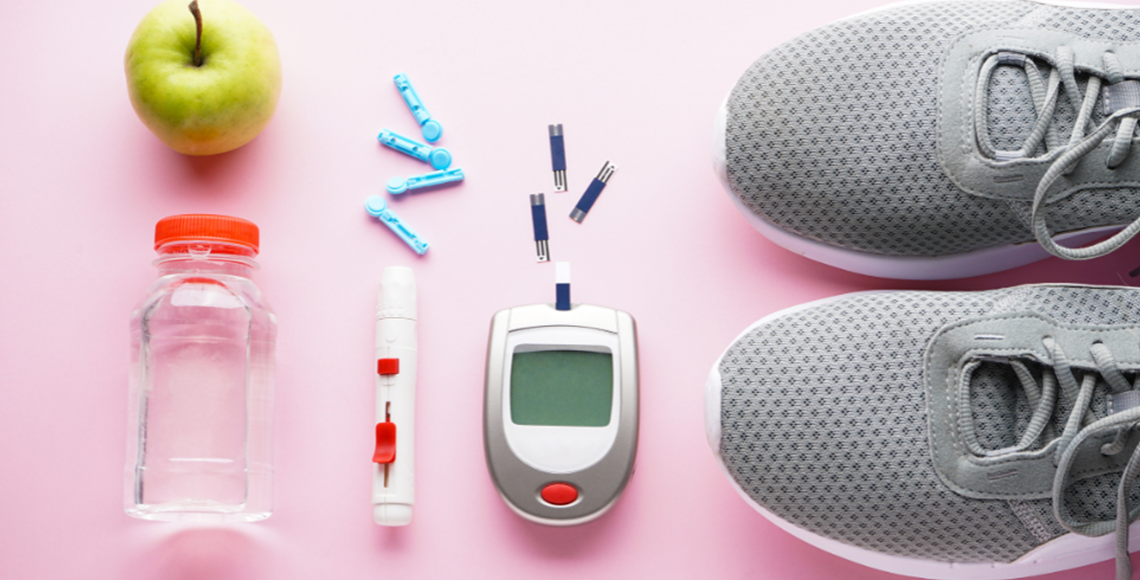How Strength Training Helps Manage Type 2 Diabetes
As women, we sure are busy! Between working, caring for kids or grandkids, and all the other things we juggle in our lives, exercise sometimes takes a back burner.
But working out is important, especially if you have type 2 diabetes. A regular exercise routine that includes strength training for women is one of the most powerful things you can do to keep type 2 diabetes under control.1
One reason it’s good to engage in both aerobic exercise and strength training for diabetes is that when you lift weights, your muscles use energy. To get that energy, your body burns glucose (sugar). The more you exercise, the more glucose you burn. And if you have diabetes, exercise makes your body more sensitive to insulin, the hormone that helps your body use blood sugar for energy. Combination strength training and aerobic exercise routines like the Curves circuit help the sugar in your bloodstream to move into cells, where it can be burned for energy rather than expelled through your kidneys.2
Lower blood sugar levels mean a lower risk for health complications from diabetes, such as nerve damage and heart disease.3
The results you get from strength training will help control diabetes, too. Muscle burns more calories than fat, so the bigger and stronger your muscles, and the less fat you have on your body, the more calories you will burn and the less insulin you will need. More calories burned and less insulin equals better blood sugar control.4
As your muscles grow, they also get better at storing glucose, which helps your body regulate its blood sugar levels. And because you exert so much energy when you lift weights, strength training is a great way to lose weight and keep it off. Weight control is very important if you have type 2 diabetes.5
If you’ve been strength training for diabetes, great! Keep up the good work. One of the most rewarding parts of strength training is the more you do it, the stronger you get, and the heavier the weights you can lift.
If you’re new to exercise, our 30-minute workouts for women are the perfect way for you to start your journey to strength and better health. With your Curves Coach at your side for every workout, you’ll get the guidance you need to ensure a safe, effective full body workout. And as we have talked about, the Curves workout is great for diabetes control, too. The American Diabetes Association recommends you exercise moderately for 30 minutes per day, five days a week. The Curves Circuit provides regular aerobic exercise for diabetes control, strength training, and improved fitness, balance, and flexibility.6
Because it combines strength training and aerobic exercise, the Curves Circuit is an ideal program if you have diabetes. Plus, regular strength training and aerobic exercise have been shown to help prevent heart disease, boost mental health, and help you achieve and maintain a healthy weight. If you have diabetes or any other medical condition and are thinking of starting an exercise routine like the Curves Circuit—or getting back to one after taking a break—talk with your health care provider to make sure it’s safe for you.
Brush Up On Your Type 2 Diabetes Knowledge
To make informed decisions about your health, it’s important to be aware of relevant health issues, like diabetes. Here are 5 things you need to know about type 2 diabetes.
1. Diabetes affects the way your body treats sugar (glucose) in your blood. Your pancreas makes insulin, a hormone to turn glucose into energy, but if the pancreas can’t produce enough insulin or your cells become resistant to it, sugar begins to build up in your blood. When there is too much circulating glucose, your cells don’t receive enough energy, and over time, high blood sugar levels could possibly harm your eyes, nerves, heart, and kidneys.
2. Symptoms of type 2 diabetes can sometimes be mild. It’s estimated that about 8 million people don’t even know that they have type 2 diabetes. Signs to watch for include: feeling tired, blurry vision, peeing a lot, being thirsty, recurring yeast infections, and tingling or numbness in your hands and feet.
3. Type 2 diabetes can sometimes be managed with healthy eating and increased physical activity, but often a doctor will prescribe an oral medication and possibly insulin to help keep blood sugar levels in check.
4. Some risk factors are uncontrollable, like if you’re over 45 years old and have a parent, brother, or sister with type 2 diabetes, your genetics or age can’t be changed. However, other risk factors are related to your daily habits and are manageable, including your weight, physical activity, stress level, and amount of sleep each night.
5. Behavior changes in your lifestyle can help prevent the onset of type 2 diabetes. Losing around 10 percent of your weight can slash your risk for developing diabetes in half. Experts also recommend 150 minutes of moderate physical activity per week, like the strength training and cardio you get from a Curves workout, can help reduce your risk. Eat smart by avoiding trans and saturated fats, sugary soft drinks, and processed carbs. And, of course, quit smoking.
A type 2 diabetes diagnosis can feel crushing. If someone you know has diabetes, it’s recommended that you are sensitive to others and refrain from labeling. A positive reaction would be to offer your support by joining in healthy lifestyle habits and recognize how difficult it might be to regularly monitor and manage blood sugar levels. It is always a good idea to refrain from offering unsolicited diet advice.
The Curves circuit is a great way to lower your diabetes risk. Curves offers a new Workout of the Week, WOW, each week that features moves from balance, boxing, body basics, and cardio adding variety for women to strengthen your whole body. Following a healthy diet and engaging in a workout that includes strength training workouts is vital, especially if you are at an increased risk for the disease. Your local Curves gym is the perfect solution to help you get fit, gain strength, and stay healthy. You’ll get an efficient, effective 30-minute full-body workout and improve your health at the same time.
3 Health Tips to Help Prevent Diabetes
There’s no better time than right now to take stock of your health and fitness, evaluate your risk of diabetes, and make sure you are doing everything you can to prevent this potentially devastating disease. Some of the best ways to prevent diabetes and keep it under control include taking stock of your diabetes risk, adopting a regular exercise program like the Curves whole body workout, and following a healthy eating plan. Begin preventing diabetes right now with these three steps:
1. Check for prediabetes.
Prediabetes7, as its name implies, is a precursor to diabetes. It’s defined as a blood sugar level that is high but not at the level of diabetes, and it puts you at a greater risk for developing type 2 diabetes than someone with a normal blood sugar level. If you have prediabetes, you likely won’t know it because, generally, there are no physical symptoms, but certain factors put you at greater risk: being 45 years of age or older, having a family history of diabetes, being overweight, exercising less than three times a week or having had gestational diabetes.
The United States Centers for Disease Control and Prevention (CDC) offers a simple 7-question screening test for prediabetes8. If you score high, make an appointment to see your healthcare provider to discuss your diabetes risk and consider getting your blood sugar tested. Weight loss of 5-7% along with engaging in a moderate exercise routine for 150 minutes a week, will reduce your risk for diabetes by 58%. For support to achieve that goal, see the CDC Registry9 of recognised programs for diabetes prevention.
2. Engage in a regular exercise plan.
Regular physical activity is one of the most important steps you can take to prevent diabetes. Muscle burns glucose for energy. The more you move, the more your muscle cells pull blood sugar out of circulation and into the energy production furnace. And when you engage in regular workout plan that includes strength training for women like the Curves workout, your body becomes more efficient at using glucose.
Finally, a regular full body workout will help you get to and maintain a healthy weight. The CDC recommends 150 minutes of moderate exercise a week. The best exercise for diabetes prevention? A combination of cardio workouts and strength training for women. Cardio workouts and resistance training impact the muscle in different ways. It’s a case of 1 + 1 equals 3. Cardio plus strength training for women? Sounds like a Curves whole body workout, right?
3. Adopt a healthy eating plan to help prevent diabetes.
Weight management is key to avoiding this disease, so following a weight loss eating plan is important. Some of the most important elements of a diet plan for women at risk for diabetes: keep an eye on portion control, cut out sugary drinks, and avoid high-calorie foods. Reduce your intake of saturated fat, the enemy of a healthy weight and heart health. Fill up instead on high-fiber foods: whole grains, beans, and fresh fruits and vegetables. Fiber is a great part of a weight loss eating plan because it helps you feel satisfied throughout the day, so you don’t overindulge during or between meals, and it helps to slow the release of sugar into your body.
If you do eat between meals, choose healthy snacks, such as carrots with hummus, an apple with peanut butter, or a low-fat cheese stick. Keep in mind that in addition to being important for weight loss or control, whole foods also pack lots of vitamins, minerals, and other nutrients important to good health and are the cornerstone of a healthy eating plan. Knowing your risk for diabetes, exercising regularly with a workout plan like the Curves workout, and following a healthy diet plan for women puts you on the best path to preventing diabetes.
How Curves Can Help
Whether you’re engaging in exercise for diabetes, trying to lose weight, or simply want to get healthier, getting started with a regular exercise routine and staying motivated can be challenging. At Curves, we will help you every step of the way.
The Curves Nutrition & Weight Management Program will help you better understand nutrition and weight management, so you can adopt healthy eating habits you will keep for life. And the Curves Circuit will give you the full body workout you need to improve your wellbeing, stay strong and maintain a healthy weight long term. It is always recommended that you consult your primary care provider before beginning any nutrition or exercise program.
For more information about Curves, visit ‘Why Curves’ and to find out more about how you can make informed lifestyle and health choices, visit our blog under the ‘Live’ category!
Sources
- Get Active! | Diabetes | CDC
- Blood Sugar and Exercise | ADA (diabetes.org)
- Get Active! | Diabetes | CDC
- Blood Sugar and Exercise | ADA (diabetes.org)
- Blood Sugar and Exercise | ADA (diabetes.org)
- Blood Sugar and Exercise | ADA (diabetes.org)
- Center for Disease Control & Prevention
- American Medical Association
- Center for Disease Control & Prevention







